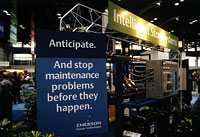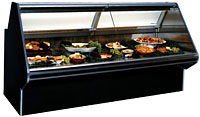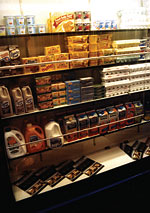
But instead of encountering systems that seem to be a mish-mash of pieces and parts, they could well discover technology that was the result of careful and coordinated planning.
The message from the most recent Food Marketing Institute (FMI) Expo was that manufacturers are working together to develop the most efficient and cost-effective systems for specific applications. And, while the end user still has the final say in what goes in the store, various consortiums of consultants from within the ranks of equipment manufacturers are offering what they contend is objective guidance.
One example of this trend was the announcement by Kysor/Warren (www.kysorwarren.com) about additions to its Alliance Partnership program. Jim Knudsen, vice president, sales and marketing, said the program consists of "a select group of suppliers who have agreed to team with Kysor/Warren to conduct cooperative research, product development, and marketing programs."
The latest additions to the program are Mayer Electric, Bohn, Emerson Climate Technologies' Flow Controls, and Sporlan Valve. They join Anthony International, Astro Air, BASF, and three other Emerson Climate Technologies businesses: Copeland, Computer Process Controls (CPC), and Retail Services.
Part of the equation is "the development of products to incorporate the latest technology and integration of new technologies to optimize performance of refrigerated cases and systems," Knudsen said.
Ralph Schmitt, president of Kysor/Warren, said, "We believe our product and services offerings are broader and deeper when we partner with key suppliers for technical research, product development, and special marketing programs."

The Big Picture
Another example of looking at the big picture and going beyond the components is a concept from Emerson Climate Technologies (www.emersonclimate.com) that was talked about at the spring expo.Emerson is in the process of developing an "intelligent store architecture" that "would integrate equipment, services, and monitoring with the asset management of everyday business functions to enhance store operations and improve energy efficiency," according to the company.
"It provides a framework to design products, software, and services that work better together."
The company said that currently the concept is comprised of CPC's E2 Facility Management System, Copeland's integrated compressor electronics, Flow Controls electronic stepper regulator valves, and Retail Services ProAct® monitoring services.
According to the company, the "intelligent store architecture represents a shift in how the retail industry thinks about retail systems and operations.
"Rather than looking at individual components within the system, this approach integrates the individual components into a broad, storewide system architecture - an architecture for advanced electronic control and monitoring of refrigeration, HVAC, lighting, and other store systems. The system would gather data and combine the power of predictive intelligence to improve the performance of store systems and give retail operators better control over equipment and maintenance costs."
"By monitoring equipment, mechanical systems, and business functions, the new architecture will be the premiere facility control and information system for the retail market," said Ross Dueber, vice president of strategic planning and platforms for Emerson Climate Technologies.
The ProAct technology alluded to is provided by Emerson's Retail Services. Currently, it is an Internet-enabled service that manages many different facets of store operations, including energy, alarms, control settings, and food quality.
The new refrigerant management function helps supermarkets maintain the documentation that is required to maintain compliance with Section 608 of the Environmental Protection Agency's Clean Air Act.
The company said, "ProAct Refrigerant Management helps supermarket operators organize their refrigerant-related inventory information quickly and easily, effectively reducing labor costs and increasing productivity to key personnel, while also minimizing refrigerant loss due to leaks or reduction of inventory.
"And by providing all the proper documentation, Emerson Climate Technologies helps operators close the loop between the technicians who complete the work and the owners who have the responsibility for compliance."
Also creating linkage among many manufacturers is Invensys Climate Controls (www.invensys.com). The company announced the expansion of its Eliwell brand of electronic controllers from Europe into the U.S. market. This means the brands now encompass Com-Trol, Eliwell, Ranco, and Paragon.
"We are bringing together brands customers know and trust under the umbrella of Invensys Commercial Refrigeration Controls to deliver the latest technology to our customers from a single supplier," said Dan Wesner, global industry manager for commercial refrigeration.
New products in the equation include Com-Trol 4K2e, which is designed to provide control of refrigeration, HVAC, and lighting in a single product; Com-Trol 6KLite, a remote graphical user interface; and Eliwell DigiFrost electronic controllers, which come from Europe and are designed to replace multiple electromechanical refrigeration products with a single device.

The Power Factor
Rising energy costs have been a concern of the supermarket industry for years as stores continue to operate on the thinnest of profit margins. Industry manufacturers are constantly introducing ways to curb costs, from refinements within components to major electrical distribution solutions.A case of the latter comes with electrical power units titled PowerCenter, PowerWall®, and PowerPlus from Hill Phoenix (www.hillphoenix.com). These electrical distribution units are being promoted by the company as an integrated power solution.
"By controlling how electricity is disseminated throughout a facility, the three products provide power distribution, energy management, lighting controls, standby power systems, and emergency power, all from one central location," said Van Fears, general manager for electrical distribution products at Hill Phoenix.
"In the past two years, the marketplace has opened up and retailers are seeing that integrated systems work," he said. "We've found a niche in the market by providing a secondary answer instead of a primary one." He indicated that benefits include a reduction on construction time, a reduction in labor costs, and the use of less floor space.
Construction and labor costs are reduced, Fears said, because products are preassembled to customer specifications. "Contractors simply install the products and the system is fully operational," Fears said. The space issue is dealt with by double-stacking PowerPlus systems.
"In a standard design, contractors must build cabinets and install panels side by side, usually resulting in an electrical wall 10 to 20 feet wide. But by reducing an electrical room's size by using PowerPlus, retailers will see a cost reduction."

Compressor Considerations
Fine-tuning and innovations within the mechanical refrigeration system continue to come from industry manufacturers.During the most recent expo, much attention was paid to digital scroll compressors in parallel racks. For example, at the booth of Kysor/Warren, research between that company and Emerson Climate Technologies has resulted in what Randall Shoaf, Kysor/Warren's director of engineering for systems, called "a real revolution in this field."
He said the process starts with the standard parallel rack, which varies the use of multiple compressors to meet different refrigeration loads. Copeland Digital Scrollâ„¢ compressors are added "in a patented design to continuously adjust cooling power to precisely maintain the desired temperature and humidity level."
Shoaf maintained that the compressor highlighted "is the first scroll with a built-in capability to operate from 10 percent to 100 percent capacity, matching the refrigeration load more accurately than traditional compressors."
The result, he said, is a system with precise control over capacity and power consumption.
Also in the compressor arena, Kysor/Warren reported on compact scroll systems (CSS) for use in low-profile applications such as over walk-in coolers, in motor rooms, or in small back rooms. At 42 inches tall, the packaging is said to be about half the height of standard parallel racks, while still maintaining capacity. The size was said to eliminate the need for mezzanines in back rooms or placement on rooftops.
Hussmann Corp. looked at new directions with parallel racks with use of IR Impact compressors, which come with dual voltage on all models from 6 hp and above; the units feature multiple refrigerant capabilities. The design allows for one compressor version to be used for all temperature ranges using R-404A, R-507, and R-22.
The unit uses a single casting with only a motor end bell cover and front bearing cover. There is no bottom plate with bolts. There is one-step capacity control on four-cylinder models down to 3 hp and a two-step capacity control on all six-cylinder models from 22 to 70 hp.
Another aspect of compressors was the use of a suction cutoff unloading capacity control system. The feature was shown on various models of compressors from Carlyle down to 3 hp.
The process is designed to allow for the unloading of two cylinders at a time in single or multiple compressor applications. "With this capacity control, compressors more closely follow the system load," said the company.

Lubrication
The age-old question of adequate yet not excessive lubrication has been complicated by a variety of non-mineral oils introduced with the advent of new refrigerants. Several new developments in the industry are addressing those issues and others.A new oil management system for parallel racks has been developed that is designed to prevent liquid from entering the suction side of a system.
As marketed as No Oil Worries by Kysor/Warren, the concept "offers excellent protection for and extending the life of compressors," said Shoaf.
He noted that in traditional parallel systems, oil and refrigerant can enter the suction side of compressors through air suction lines. But in refrigeration systems equipped with a No Oil Worries unit, the unit is designed to filter out any liquid from the suction lines before it has a chance to enter the compressor.
"Any captured refrigerant is vaporized by contact with superheated gas," said Shoaf. "Captured oil is separated out, filtered, and then returned to the crankcases when the oil level is low."
Another approach to lubrication issues involves enhancing the lubricity of the oil to reduce friction drag in the compressor. A product designed to do this called Zerol Ice was introduced by
Nu-Calgon (www.nucalgon.com). Officials also said the product enhances the thermal properties of the oil, noting, "This helps lubricity as well, but it also results in small gains in heat transfer or cooling performance in the evaporator and condenser." The product can be used with mineral, AB, and POE oils.
Satellite Cooling
At the FMI show, hardly a year goes by when unusual ideas aren't introduced. In some cases, they become reality. Several years ago, a means to keep a huge slab of stone frozen was shown, and within a year or so became the focal point in an ice cream franchise where employees custom mix concoctions in front of the customers.At the recent expo, the idea of the moment was the Satellite Cooling System (www.satellitecool.com), aimed for tabletop buffets as used for brunches or banquets. The approach was designed to allow cold foods to be served over a period of time without need for ice.
As explained at the exhibit booth, display trays and modules are designed to be hooked in series. The modules are then cooled by a food-grade glycol. A compressor sits beside the table and is powered from a 110-V outlet. The glycol compressor cools multiple modules. The modules connect with quick-release connectors that are designed to seal in fluid.
Glassed In, Covered Up
It is the mechanicals of refrigeration systems that are of most interest to contractors and technicians, but the FMI show is also designed to dazzle potential buyers of products, so manufacturers spotlighted glass display case innovations.For example, Kysor/Warren showed a Q-series of dairy, deli, ice cream, and frozen food cases. "The Q-Series enables (technicians) to raise case evaporator operating temperatures to 23 degrees F from 15 degrees and still adhere to the FDA's Food Code and NFS/ARI standards," said Ali Masood, Kysor/Warren project engineer.
"In a medium-temperature application, every degree increase in the operating evaporator temperature results in compressor power savings of about 2 percent. Therefore, the Q-Series equates to a dramatic reduction in day-to-day energy usage."
Hussmann noted its expanded line of Impact Elite display cases had "a dramatic appearance, with appealing contours, and eye-catching case designs." The company also noted high-efficiency modular coils, lift-up fan plenums, and pre-adjusted expansion valves.
Supermarkets are not necessarily 24-hour-a-day operations in all locations. Some close late each evening and reopen the next morning. Many operate for 24 hours six days a week but close from midnight to 7 a.m. on Mondays. That means the need for energy conservation in display cases and an interest in temporary coverings.
Both Eliason (www.eliasoncorp.com) and Econo-Frost (www.econofrost.com) were among companies showing such products.
On The Road
Also part of the food chain in the supermarket industry are the refrigerated trucks that bring products to the stores. That aspect of the field was represented by Thermo King (www.thermoking.com), which displayed a range of technologies. The company had four announcements in conjunction with the FMI Expo.New products offered included the SB-110 trailer refrigeration unit with the SR-2 controller, which is targeted for dairy and deli product drivers making shorter trips and in-city deliveries. The controller has a simplified user interface and technology designed to reduce product shrinkage, prevent top freezing, and extend product shelf life.
Also featured was the Trac-Kingâ„¢ wireless remote monitoring and GPS systems, a real-time asset management system for temperature-controlled transport applications. According to the company, customers can choose between a satellite-based system and a cellular-based system that uses a global system for mobile communications.
Thermo King also displayed the Datalogger Jr., which is designed to verify in-transit product temperatures, and Thermo Kare Gold, a maintenance program designed to keep controllers running at maximum efficiency.
Sidebar: Last Installment Of FMI And NRA Show Coverage
This is the last of three articles covering the latest in refrigeration-related technology based on two major trade shows that took place this past spring - The Food Marketing Institute (FMI) Expo and the National Restaurant Association (NRA) show. The July 5 issue ofThe Newshad an article on ice machine-related technology, and reach-in and walk-in coolers and freezers were covered in the Aug. 2 issue. This article focuses on additional aspects of supermarket refrigeration technology.Publication date: 09/06/2004


Report Abusive Comment